I made 6 gallons of liquid soap so you don’t have to.
You know about Dr. Bronner’s Liquid Castile Soap. It’s been an all-in-one, all-natural cleaning solution for generations of hippies, greenies and all manner of natural living advocates. Dr. Bronner’s is great, but it’s not the cheapest cleaner out there.
So, these were my goals: to create a cost-effective, basic liquid soap that most people could make with the gear they have around the house and commonly available oils.
I wanted a recipe that was reliable, safe and performed similarly to Dr. Bronner’s in home and body care recipes. The result should be enough finished soap to make this worth the DIY hassle, but not so much soap that it would be overwhelming to store or use in a reasonable timeframe. My goal was a total of about 1 gallon of finished liquid soap.
Two weeks and 6 batches of liquid soap later, I think I’ve gotten it down. Wanna make your own liquid castile soap? Here’s how I do it.
1. Assemble Your Stuff
Like any true soap, liquid castile soap is made through the chemical reaction of fats and a very strong alkali called lye. This reaction is called saponification; when it’s complete the fat and lye are totally transformed into a new thing we call soap.
Tools You’ll Want To Make Liquid Castile Soap
The process of making liquid soap is make a zillion times easier if you have:
- A large crock-pot (6 quarts or larger, please). If you don’t already have a crock-pot, check the thrift store first. I have an older version of this crock pot. It’s fine. I think they are all about the same, honestly.
- An immersion blender – I like the kind with a stainless blender attachment.
- A reliable digital scale that can measure both ounces and grams. I have this kitchen scale. It’s been really good.
Any time you’re working with lye, use only heavy-duty glass or stainless bowls. No aluminum, please, or you’ll find both your soap and your vessel quite destroyed.
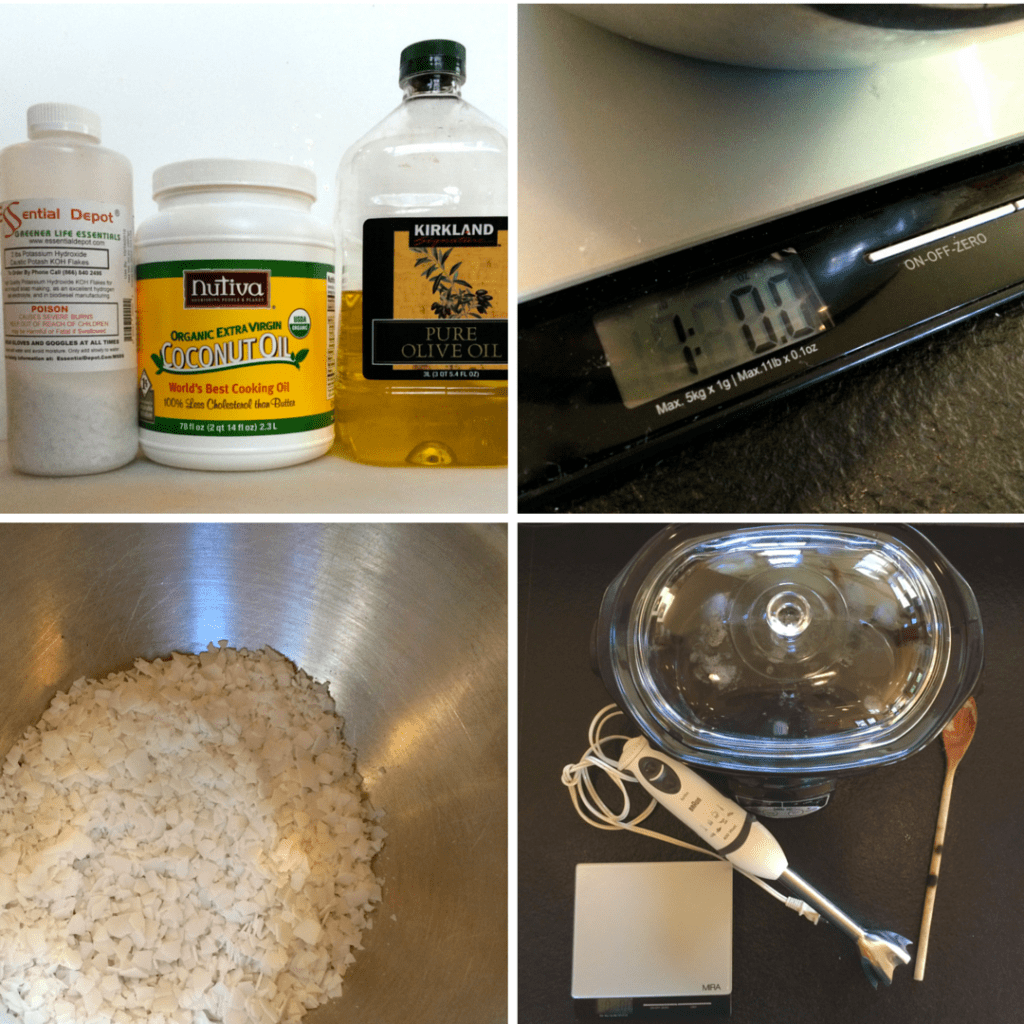
Essential tools: crock pot, immersion blender, digital scale.
Lye For Liquid Castile Soap
Liquid soap is made with a type of lye called potassium hydroxide. This is the lye you want.
Potassium hydroxide is different from sodium hydroxide, the drain cleaner lye used to make a hard bar soap.
These two lye saponify differently, are used at different rates, and result in different textured soaps. So, even though both are called lye, sodium hydroxide and potassium hydroxide are not interchangeable in soap recipes.
- Potassium hydroxide saponifies fats without forming hard, opaque crystals so the resulting soap can be diluted to a liquid consistency without getting gloopy.
- Potassium hydroxide tends to give a more bubbly lather, highly desirable in liquid soaps.
- Potassium hydroxide is only about 90% pure as compared to nearly 100% pure sodium hydroxide, and this must be accounted for when you create a liquid soap formula. (See more about this in the Lye Calculations for Liquid Soap sidebar)
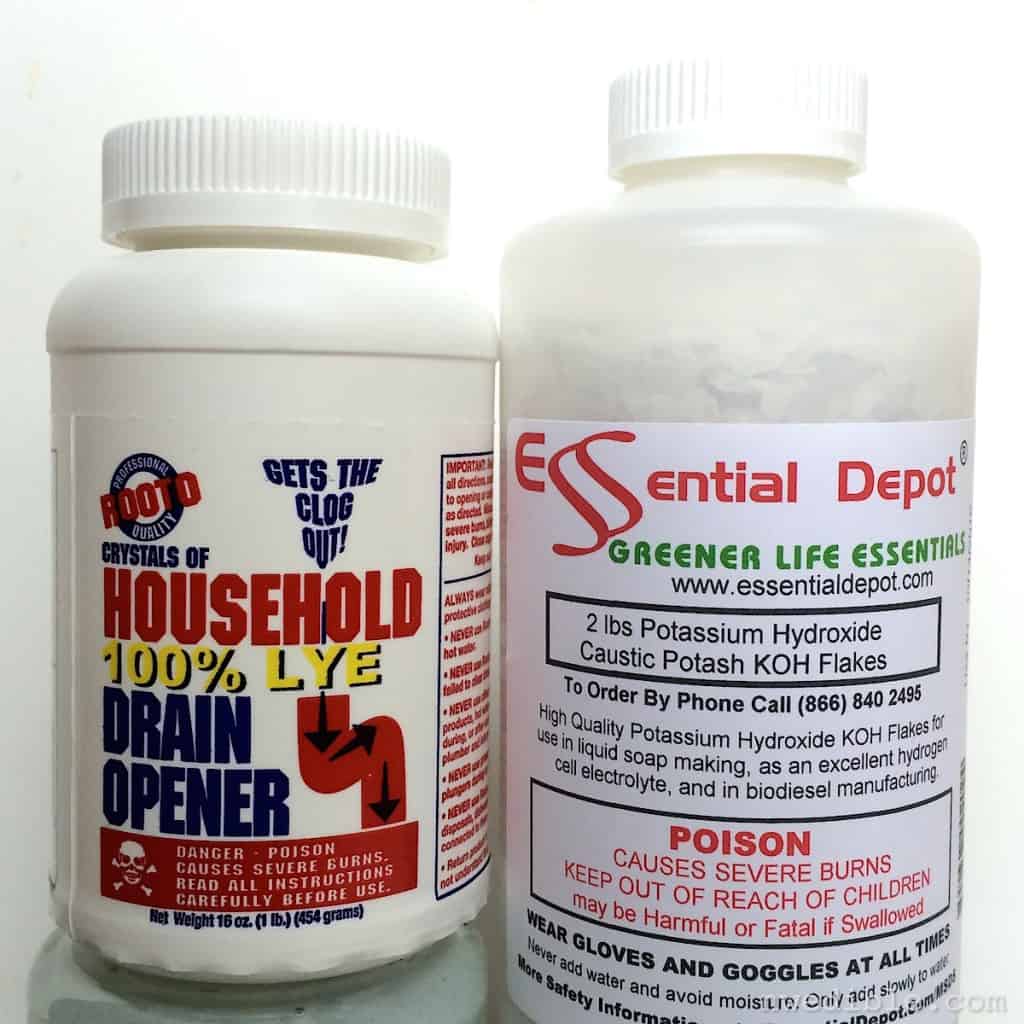
Sodium hydroxide for bar soap on left; Potassium hydroxide for liquid soap on right.
Oils For Liquid Castile Soap
Castile soap is made exclusively with vegetable oils. There will be no lard, tallow, or other animal fats in a Castile soap. Traditionally, a Castile soap was made with 100% olive oil, but modern Castile-style soaps, including Dr. Bronner’s, blend in other vegetable oils, like coconut.
For my liquid soap, I used a 60/40 blend of easy-to-find olive and coconut oil. That’s what you’ll see in this tutorial.
- Olive oil is mostly long-chain fatty acids. Olive oil soaps have a fine, moisturizing lather that’s gentle on the skin but can feel slimy on its own.
- Coconut oil is full of medium-chain fatty acids which create a soap with strong cleaning ability and big, well-structured bubbles. Coconut oil soaps can be drying because they grab and hold oil – i.e., clean – really well
Put coconut and olive oil together and you get, in my opinion, a nice, all-purpose liquid soap with good bubbles. The result is a cleanser that is strong enough to tackle greasy grime in your kitchen while still being skin-friendly.
2. Prepare The Oils and Lye Solution
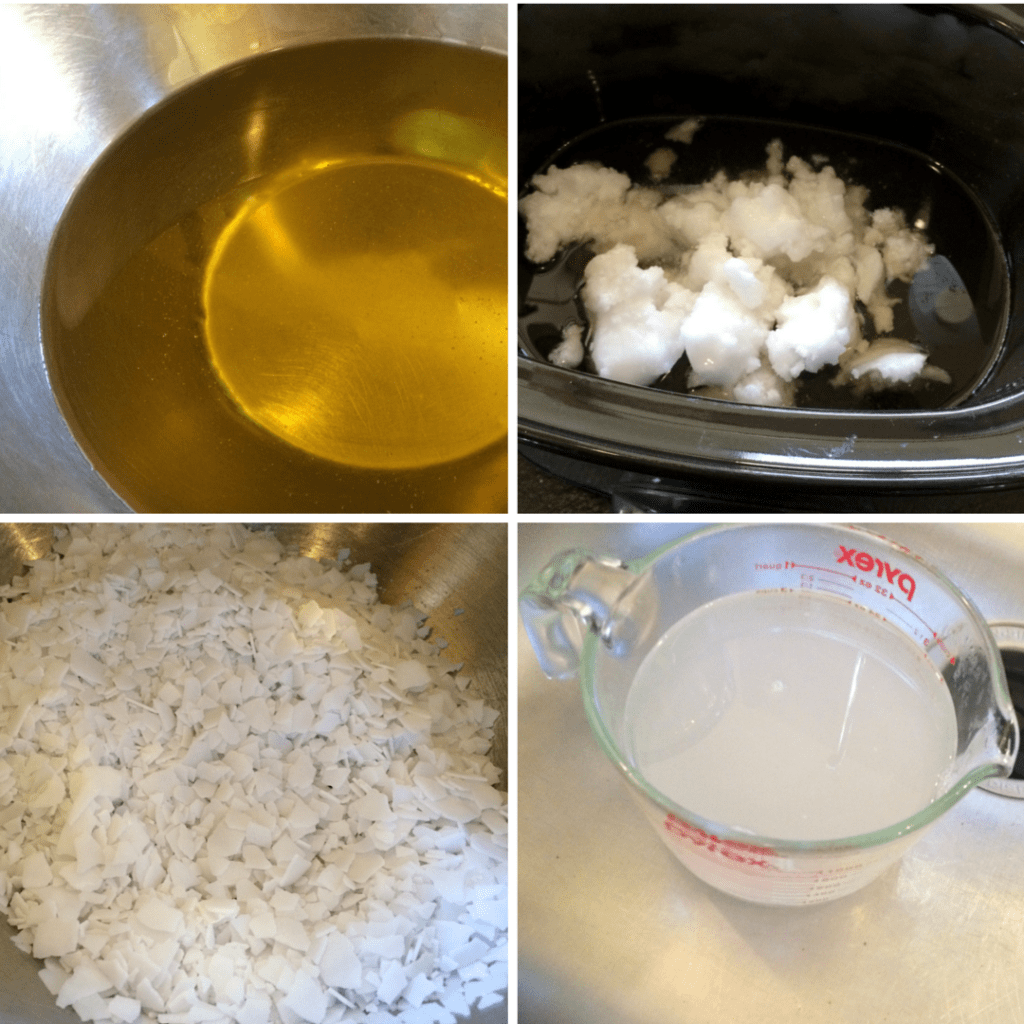
Measure all ingredients carefully. No one wants a Fight Club situation.
Carefully measure the olive oil and coconut oil into your big ol’ crock pot. Turn the heat to high to allow the coconut oil to melt.
While the oils are warming, carefully measure the water into a stainless steel bowl or pyrex pitcher. Set the container of water in your sink.
Put on your safety gear: heavy rubber gloves, goggles, etc. Measure the potassium hydroxide lye flakes into a small stainless or heavy duty glass jar. Carefully tip all the lye flakes into the water. Never add the water to the lye – always add the lye to the water.
The lye-water mixture will bubble, hiss and look generally terrifying. This is normal. Don’t stick your face over the lye mixture or breathe in the lye fumes. The lye flakes will dissolve quickly – give them a careful stir if needed to encourage this.
3. Stick Blend Your Soap To Trace
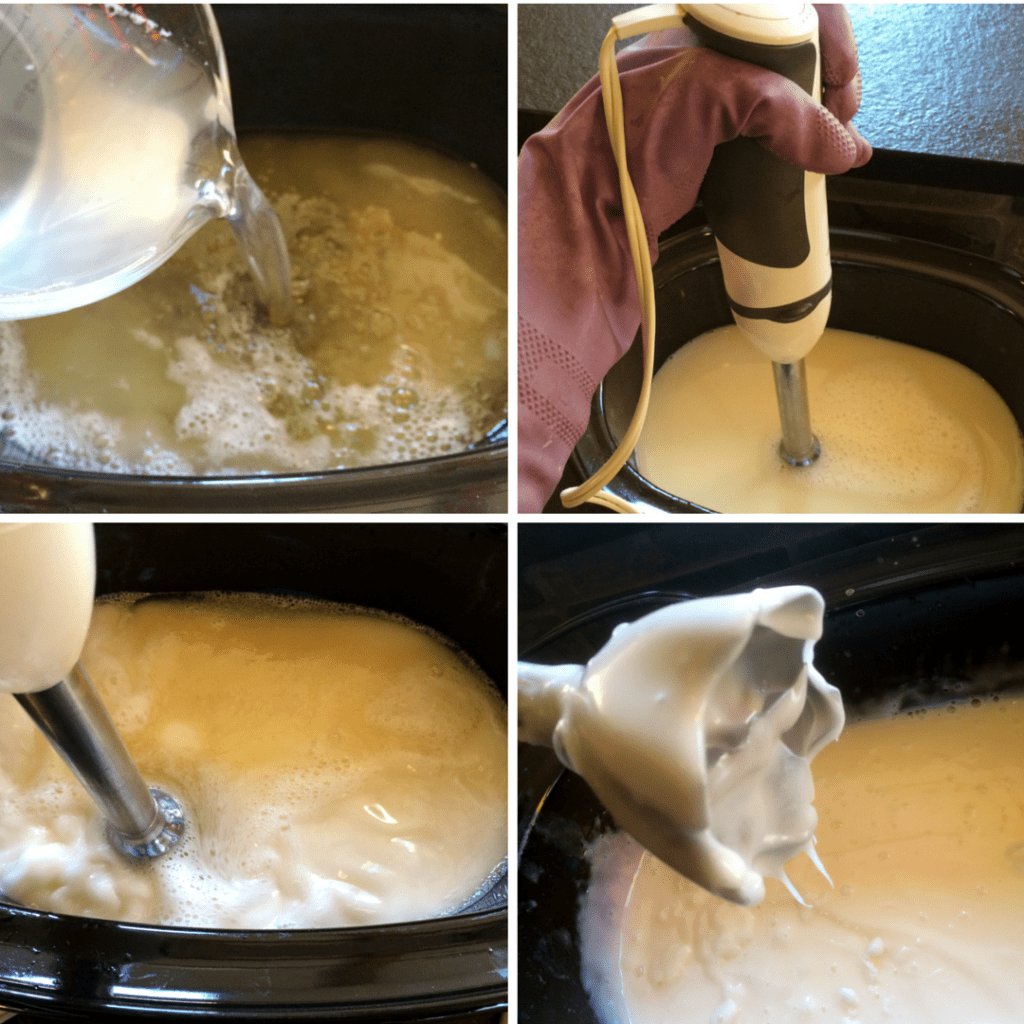
Stick blend to thick trace – look for a texture like Elmer’s glue.
You’re still wearing your gloves and stuff, right? Good – it’s time to bring the oil and alkali together to create soap, glorious soap.
When the lye is fully dissolved, carefully tip the lye-water mixture into the warm, melted oils in your crockpot.
Get out your immersion blender. Blend the soap mixture on medium until it turns uniformly creamy and begins to thicken slightly. This should take about 5 to 10 minutes.
Now, go do something else, but don’t stray too far. For the next half hour or so, come back to the crock pot every 5 minutes and give your soap a good blending with the immersion blender. Every time you show up for blending duty, you’ll notice your soap paste gets thicker, paler and more bubbly.
Keep periodically blending until your soap reaches a thick trace – you’re looking for a texture like Elmer’s glue – and it’s no longer practical to use your immersion blender in the soap.
4. Cook The Soap Paste

Give the soap paste as much time as needed to get to the fully gelled, translucent stage shown lower-right.
At this point we begin to “cook” our soap paste. With your crock pot still on high heat, adjust the timer to 3 hours and set the lid on the crock pot.
As the soap cooks, it will become increasingly translucent, moving from a runny white liquid to a puffy taffy texture to, eventually, a yellowy-clear, thick gel. This is normal. I think of these stages as:
- runny cream
- cake batter
- Elmer’s glue
- puffy white taffy
- confused semi-gelled blob thing
- translucent gel
During this cook period, we’re going to take the soap from Elmer’s glue texture to finished, translucent gel. The soap paste in the crock pot will mostly tend to itself during this time.
To keep the gel progressing evenly, periodically fold your soap paste over on itself and stir it around with a sturdy wooden spoon (very sturdy – I broke a spoon on soap batch #4) or high-heat spatula.
As the soap cooks, it will get puffy as the air bubbles trapped in the soap heat up and expand. Eventually, the paste will start to look more translucent. If your crock pot has hot spots, you may see some chunks of fully gelled soap even if the bulk of the soap paste isn’t ready.
That’s all ok.
Just aim for a good fold-over and stir about every 30 minutes or so, or more often if you can. After 3 hours, check your soap paste. When your paste is done it should look quite a bit like amber – translucent and golden.
Don’t rush getting to this stage – if your soap needs more time at the end of the 3 hours, take the time to cook the paste for longer – nothing bad will happen to the soap paste.
5. Check Clarity
Once the paste looks fully gelled and translucent throughout it is ready for the next stage.
At this point, the soap will probably be fully saponified and ready to dilute. But better safe than sorry, so before we commit to dilution, we’re going to do a clarity test.
Clarity (in combination with carefully measured lye) is a very good test of full saponification. If your soap paste makes a cloudy dilute soap, it is not done cooking. Cloudy soap* can indicate non-saponified oil (too much of this can make your soap go bad) and potentially non-saponified lye (this can cause chemical burns).
If, however, the diluted final soap is translucent enough to read through, your soap paste has finished cooking.
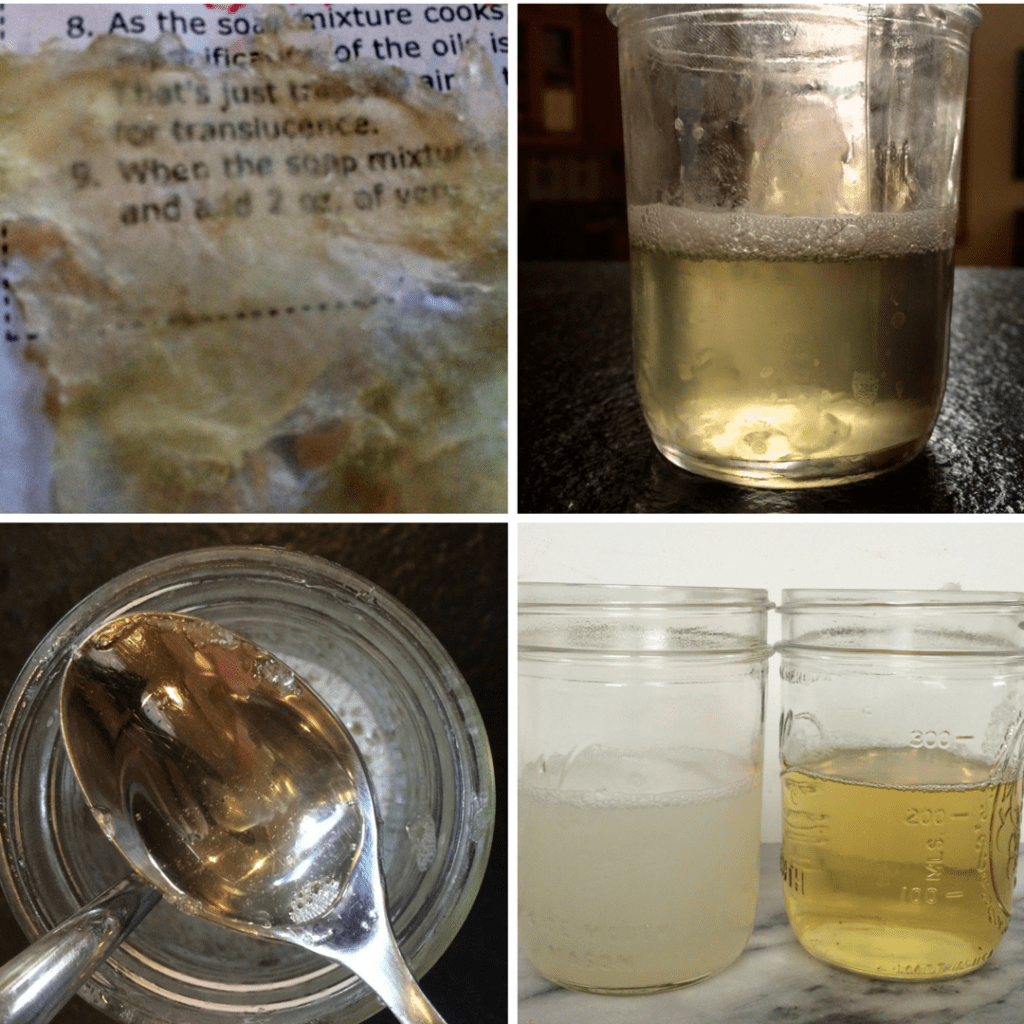
Lower-right: cloudy, unfinished soap on left; translucent, finished soap on right.
To Test Soap Clarity
- Measure out an ounce of soap paste (about a golf-ball sized blob will do it).
- Add 4 oz (1/2 cup) of boiling or very hot water to the soap paste. Stir gently until the soap paste is totally dissolved.
- Allow the dilute soap to cool.
- If the soap is opaque, or if a scum of oils floats to the surface, continue cooking your soap paste for another hour or two before re-testing.
- If the dilute soap is clear or slightly pearlescent (the soap won’t be colorless, just translucent), proceed with dilution.
*Alternate Oils and Clarity
If you change up the oils in your soap – and particularly if you use tallow, lard, palm, or other “hard” fats – you may end up with a soap that never becomes completely clear.
There’s nothing you can really do about this, as I understand it – it’s just a matter of the type of fatty acids in certain oils.
The coconut and olive oils used in the formula given here should cook out to a fully gelled soap paste in between 3 to 6 hours, depending on the temperature of your crockpot, how often you stir, etc.
6. Dilute the Soap Paste
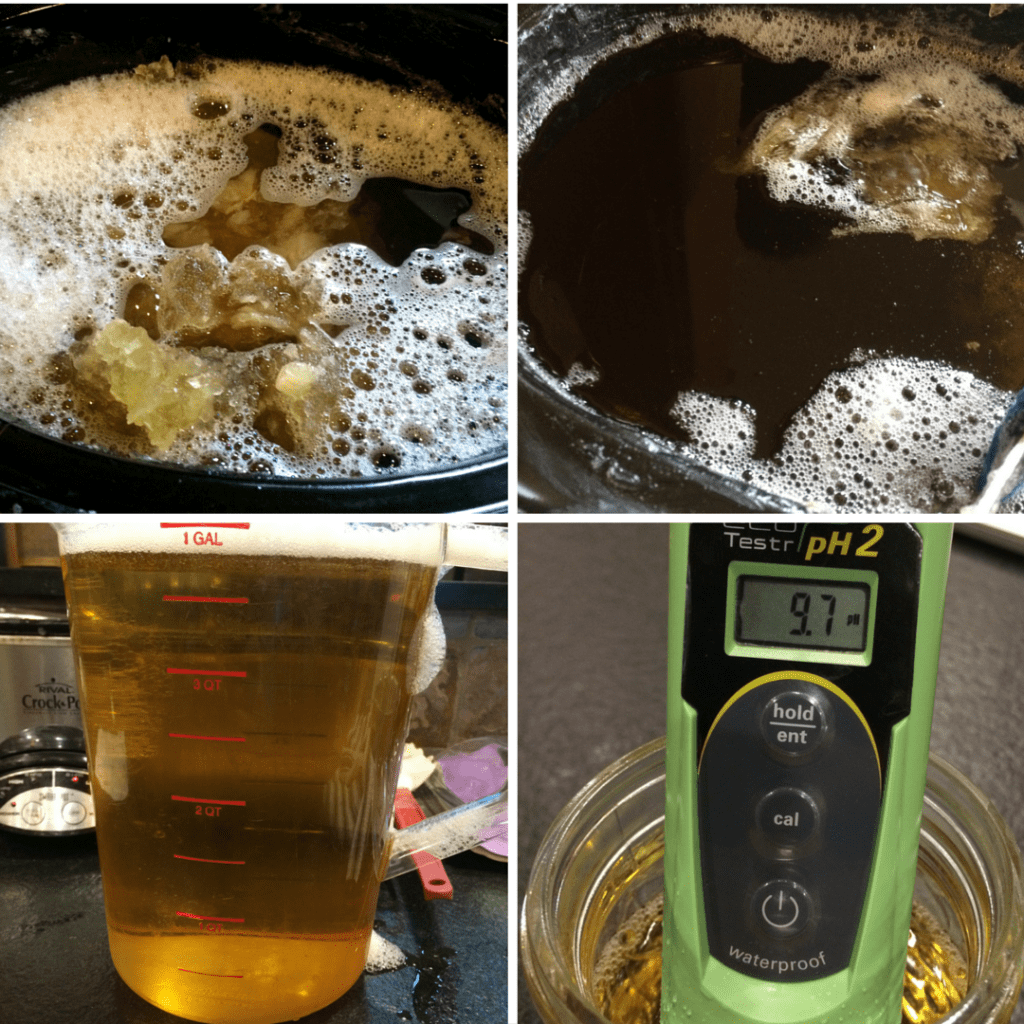
The melting process is very slow.
Once the soap paste has fully gelled, proceed with dilution. Like the cook phase, dilution of the paste is a sloooowwww process, but the soap will pretty much take care of itself.
Add 10 cups distilled* water to the soap paste in the crockpot. Break up the soap paste into the water into smaller blobs of paste as best you can but don’t worry about the paste dissolving yet.
Turn the crock pot heat to keep-warm, lid the crockpot and give the soap paste all day or overnight to dissolve. If possible, every hour, or as you happen to think of it, give the soap a stir to help it along. (If you’re sleeping during this phase, don’t worry about stirring!)
If, after 8 hours-ish, you’re still seeing a lot of chunks of soap, or you see a skin forming at the top of the soap, add in another cup of distilled water and let the soap continue to dissolve. Repeat with the final cup of distilled water if needed.
When your soap is fully dissolved with no chunks of soap paste remaining, it’s ready to bottle.
*Is Distilled Water Necessary?
I call for distilled water for three reasons.
- I have no idea what the pH and mineral content of your water is. Mine is 7.4 – pretty neutral – and soft like a baby’s butt. You might have tap water so full of minerals it’s practically gravel, with a pH of 9.5. That’s just way too much starting variation for a soap recipe that doesn’t ask for pH testing and buffering.
- Impurities in water – mostly those aforesaid minerals in hard water – can cause soap to do funny things. Clumping and particulate are possible.
- There is a miniscule possibility that contaminated tap water could introduce spoilage organisms to your soap on dilution.
The most important reason is (1) – so if you have a way to test the final pH of your soap, such as a pH meter or phenolphthalein pH testing drops, and feel confident adjusting your soap pH with a citric acid or borax buffer if necessary…well, then honestly you probably don’t need this soap tutorial at all! 🙂
I have made this recipe with my own near-neutral, soft water without issue. Hard water folks might find tap water trickier to work with from an impurity standpoint.
7. Bottle and Adjust Quantity
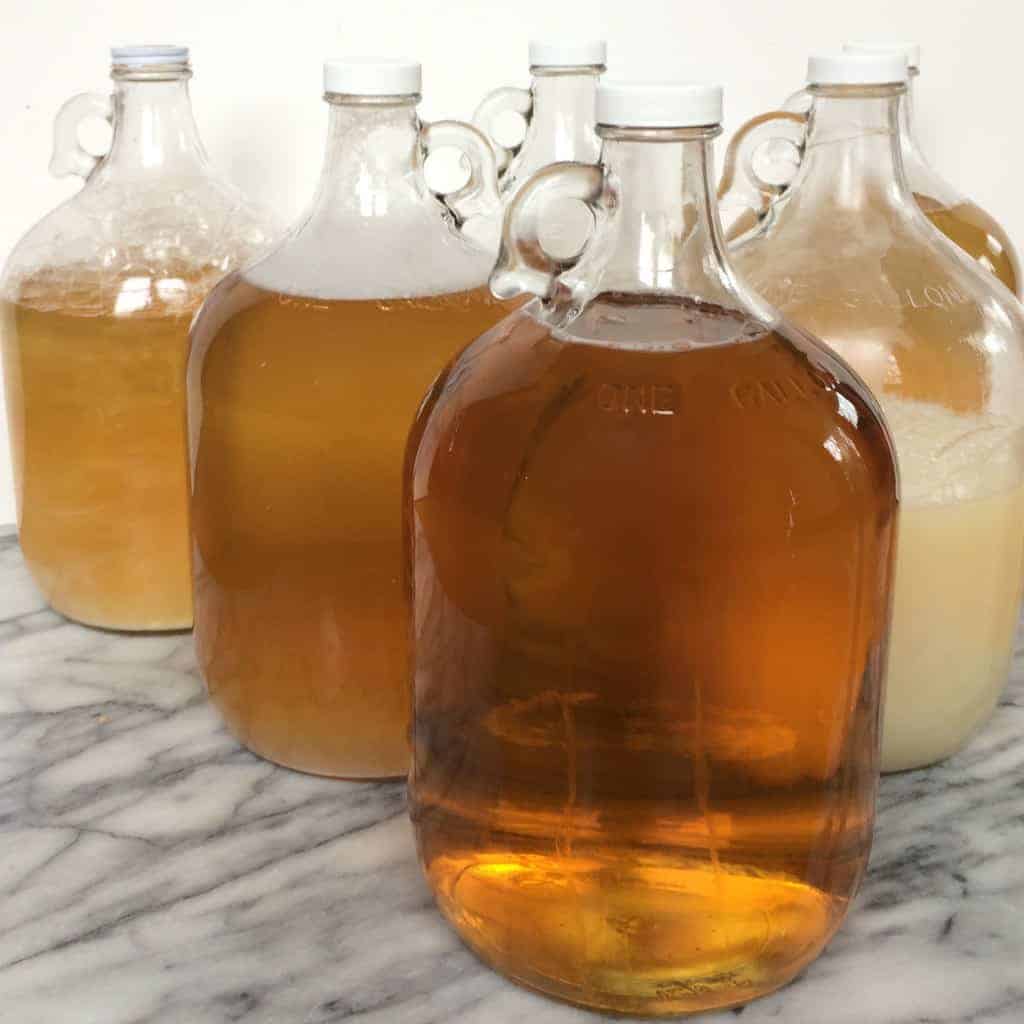
I have a lot of soap now.
Before bottling, I like to strain my soap to catch any bits of scum or soap paste that hasn’t fully dissolved. This is optional, but it doesn’t add much time.
Ladle or carefully pour your dilute soap into a perfectly clean and dry 1-gallon glass or plastic jug. Old apple juice, milk or vinegar are good for this – just ensure any reused container is thoroughly cleaned.
Your soap should be just about the right volume to fill your jug with maybe a pint or so left over for topping up soap pumps around the house.
But, because of different cook times for the soap paste, evaporation, how much water you added, etc, your soap might be a bit low. If that’s the case, just top up your soap with a bit more water until you’re at that 1-gallon mark.
Lye Calculations For Liquid Soap
You cannot simply swap one oil for another in a soap recipe.
If you prefer to change up your base oils or your base oil quantities, make sure to run your modified formula through a reliable soap making lye calculator to determine how much potassium hydroxide (often referred to by it’s chemical notation KOH) you will need to use.
Assuming you are using commonly available KOH flakes, you have to account for the fact that your lye is only 90% pure. If you have gotten your hands on some kind of industrial, super-high purity KOH you’re on your own when it comes to your lye calculations.
Good lye calculators like Soap Calc will have an option for 90% KOH. Use that formulation with a 3% superfat.
Again: you must run any variation or modification of a soap recipe (any soap recipe!) through a soap calculator to ensure safe and complete saponification. This is for your safety!
What’s The Cost?
As of the writing of this post, my cost for a batch of this soap using organic oils was as follows:
- Coconut Oil – $10.25 for 16 oz = $0.64/oz * 16oz = $10.25
- Olive Oil – $17.75 for 34 oz = $0.52/oz * 24 oz = $12.53
- Potassium Hydroxide Lye – $12.99 for 32 oz = $0.41/oz = $3.90
- Total = $26.68
Using bulk oils from Costco and the ingredient cost drops to about $18.
So, a batch of this soap should come in at about $20 – $30, depending on where you get your ingredients and if you opt for organic or otherwise more expensive base oils. That’s between one-third to one-half the cost of Dr. Bronner’s.
Printable Recipe For Liquid Castile Soap
DIY Liquid Castile Soap
Ingredients
- 24 oz weight (680 grams) olive oil
- 16 oz weight (454 grams) coconut oil
- 9.35 oz weight (265 grams) Potassium hydroxide lye flakes
- 32 oz (4 cups | 907 grams) distilled water, for lye-solution
- 10 to 12 cups distilled water, to dilute, plus extra as needed
Instructions
Make The Soap Paste
- Add the olive oil and coconut oil to a large, (6 quart minimum) crock pot. Turn the crock-pot on high.
- While the oils are warming, put on your safety gloves and goggles, and carefully measure the potassium hydroxide lye into a stainless steel or pyrex bowl.
- Measure the water into a medium stainless bowl or pyrex pitcher. Set the container with the water into your sink, then very carefully tip the lye flakes into the water. Stir to dissolve.
- When the oils in the crockpot are warm, carefully tip the lye solution into the oils. Leave the crockpot on high.
- Use an immersion blender to blend the oils and lye solution together. Immediately after adding the lye solution to the oils, blend for about 5 minutes, until the mixture looks uniformly opaque and begins to slightly thicken. For the next 30 minutes, come back and blend the soap paste about every 5 minutes. The mixture will get thicker and thicker, progressing through an icing texture to something like Elmer's glue.
Cook Soap Paste
- When the soap mixture becomes too thick to blend with an immersion blender, lid the crock pot and cook the soap mixture for 3 hours on high.
- Every 30 minutes or so, come back and fold and stir the soap paste with a heat-resistant silicone spatula or heavy wood spoon to ensure the soap paste cooks evenly.
- As the soap cooks, it will become increasingly translucent, moving from a runny white liquid to a puffy taffy texture to, eventually, a yellowy-clear, thick, translucent gel.
Test Soap Clarity
- After 3 hours, or once the paste looks fully translucent and gelled throughout, check the soap with a clarity test.
- Measure out an ounce of soap paste (about a golf-ball sized blob will do it). Add 4 oz (1/2 cup) of boiling or very hot water to the soap paste. Stir gently until the soap paste is totally dissolved.
- Allow the dilute soap to cool. If the soap is opaque, or if a scum of oils floats to the surface, continue cooking your soap paste for another hour before re-testing.
- If the dilute soap is clear (it needn't be colorless, just translucent), proceed with dilution.
Dilute the Soap Paste
- Add 10 cups water to the soap paste in the crockpot. Break up the soap paste into the water as best you can but don't worry about the paste dissolving fully.
- Lid the crock pot and turn the heat to warm for 8 hours or overnight. If you happen to walk by, give the soap a stir to help it along but don't worry if you can't.
- After 8 hours, if you notice chunks of remaining soap or thick skin of soap forming even after the chunks of soap dissolve, add another cup or two of water to further dilute the paste.
Bottle Soap
- When your soap is fully dissolved with no chunks of soap paste remaining, ladle your dilute soap into a perfectly clean and dry 1-gallon glass or plastic jug.

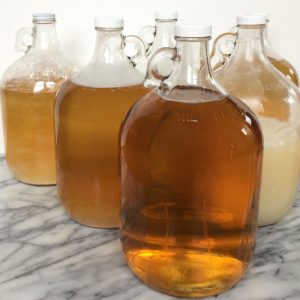
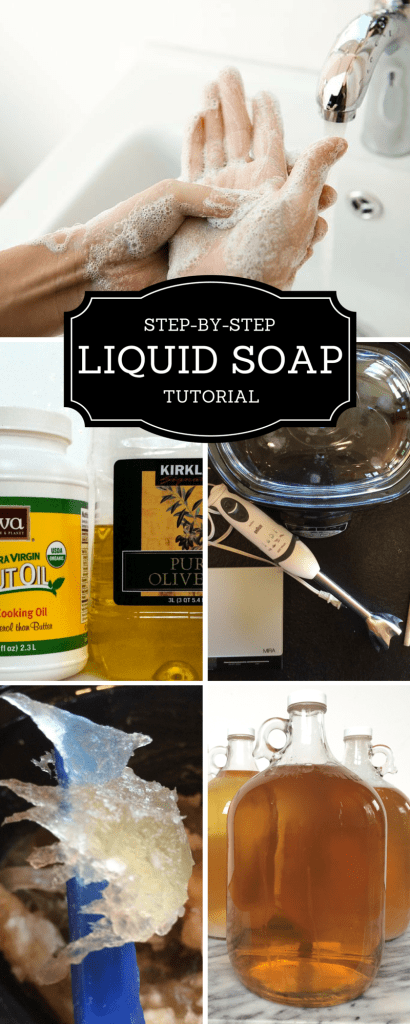
LED’s differ this way from other grow lights for example HID, which may have remained on the same lumen per watt output levels for
decades. Grow Stealth LED claims their lights use this science to generate similar results to your plants, but do
they really. Free grow lights Good lighting may make any
subject look far better and make taking difficult
pictures far easier.
This is really because various processes and chemicals associated with photosynthesis respond
most readily about bat roosting bands of light. It isn’t too
not easy to develop sweet tasting tomatoes inside your greenhouse natural environment with a little
knowledge.
Should you go with the earlier mentioned advice, you might be inside
a position to affordably and safely fix your appliances for the home.
Whirlpool cabrio dryer af error code In case of single-tub machines the lake needs being drained from using it and thereafter the drying spin will likely be started.
Pamper yourself using a massage or even a visit to your hair
& nail salon. Personally I like lights inside on the washer, means
they look cool.
hello Erica thanks for the post! one question, how do you clean the crock pot afterwards? can you still use it for normal food?
thanks!
I need help. I follow instructions but in crock pot it keeps foaming and whilst it dilutes well with pH 9.7-9 it won’t go to that Taffy. Once I added more oil and cooked longer which did work making me think I have too much lye. Soap call tell me to use a lot. Mrs is the same as the book I have Failed, bee uses less and ppl on forums. supersaturate. What should I do? My lye is 90-95% pure. I also needed to use citric twice but clouded my last batch.
I need help. I follow instructions but in crock pot it keeps foaming and whilst it dilutes well with pH 9.7-9 it won’t go to that Taffy. Once I added more oil and cooked longer which did work making me think I have too much lye. Soap call tell me to use a lot. Mrs is the same as the book I have Failed, bee uses less and ppl on forums. supersaturate. What should I do? My lye is 90-95% pure. I also needed to use citric twice but clouded my last batch. Sorry auto spell. Soap calc gives high lye. Mms and failor same. Summer bee less. Forums say to superfat.
My pure olive oil failed. Too much lye.
God I hate autospell. Soapcalc Mms Failor. Summer bee.
Can I use this soap as a sampoo
opi nail polish acrylic gel nails
225372 5685Thankyou for all your efforts which you have put in this. really fascinating information . 355588
How much further do you dilute the liquid castile soap before using? Can this be used for a newborn? If so, what ratio?
Do the ingredients need to be extra virgin? The photo of your oils shows just “pure olive oil” from Costco – so that isn’t the extra virgin. Does the coconut oil have to be extra virgin? Or would an expeller pressed refined coconut oil be ok?
Would it all be the same if I tried this recipe but halved everything? My crock pot is only 4 quart 🙁
Help! My soap looks like mashed potatoes! What do I do? What did I do wrong?
Have you made the soap with an oil other than olive oil? I’m really allergic to Olive oil. I break out in open sores. Culinary school was a blast! At the end of one semester my entire mouth and lips were open sores, and I was somewhat careful. The next two semesters I opted out of olive oil, substituting when I could, not eating the product when i couldn’t. I buy coconut oil in 5 gallon buckets. I have both expeller pressed and Virgin (Gold Label) in the house at all times. I use it for most applications of cooking and skincare. I also have avocado oil and grapeseed in the house. Thank you for your great tutorial! I will probably reference it in an upcoming blog (when I get the new blog, website, Pinterest and FB pages set up.
How much soap does one batch make?
I love this tutorial. I tried one batch so far and it was a flop 🙁 so onto try number two. The first batch just wouldnt gel. I think its because I had to slow the process at one point after the first three hours of cooking (I had to leave the house) and put the crock on warm. I think it killed my gelling. when I came back I turned it back onto high and cooked for almost 3 more housrs and still hadnt gelled. Also my first batch really foamed heavy after adding the Lye water, I think it reacted to my Blender, its stainless, but the head lost its shine after i took it out. So this time i limited the time with the blender, ive used this blender for CP soaps, and have just started the 3 hour cook. It seems to be having better. No interuptions this time too. I cant wait to see how it comes out. Thanks for sharing this recipee. I hate having to grate anything. 🙂
So try number two is still cloudy after 9 hours of cooking. still not sure what is wrong. Im going to run thru a lye calc and see if it changes anything.
Hi sorry if this has been asked, but can you use this immediately after you’re done? Because I saw in bar soap you have to wait 6-8 weeks? Also, how long is the shelf life? Thank you!
I made this recipe for the first time. Can you please tell me what the consistency of the final soap should be? Mine is kind of watery. So I’m not sure if I did something wrong.
Hi, thanks for your sharing. It’s great. Now I know how to use Soapcalc to calculate the oil and lye, but can you give me the way to calculate the amount of water to diulte the soap before bottling? I mean the ratio of water and glue soap. Thanks a lot.
Have you had any issues with spoilage since this contains water? Especially after diluting? Would you use a preservative? If so which one would be safe and effective at such high pH levels? I don’t think you could lower the pH to a level that would work for most natural preservatives while still keeping it soap. Having a hard time finding an answer to this. I think its because it doesn’t exist.
What an amazing tutorial! I just tried it for the first time and absolutely love the result! I’m so happy to be able to save a ton of money, I use liquid soap for nearly everything! Your directions were phenomenal and helped guide me through the (somewhat intimidating for the first time) process. My question for you is do you think 1 gallon is the total amount of soap made from this? I’m sure it depends how much you dilute it but I am trying to figure out the overall cost of this recipe compared to ones I have bought. Thank you!
This is just about the best tutorial for liquid soap I’ve ever seen. You can sure tell the difference between a tutorial from someone who has actually done something and one that has just copied the info from other sources. Thank you so much–this is great for a beginner like me, and I suspect I won’t ever have to bother with another recipe or method.
each time i used to read smaller posts which as well clear their motive, and that is also happening with this post which I am reading here.
Erica, I’m new to soaping (only made 2 loaves of CP soap) and am loving them since my allergies don’t permit me to use store bought soaps. I personally have not used bar soap for eons but instead use shampoo with scents that my sinuses can tolerate w/o making my allergies go crazy. My husband however does and it’s been an endless battle to find something he likes that I can tolerate once he opens the bathroom door–which is NEVER, he must shut it after leaving the bathroom (lol). I love my handmade bar soap and plan to begin making a lot for gifts for family members (birthday, Christmas, etc). I wanted to mention the site where I have been purchasing oils/butters and lye for my bar soap and lye for my liquid soap [your recipe 😀 so THANKS for sharing]. I almost bought where you do until I happened across Brambleberry where I discovered prices were less there. Here is link in case: https://www.brambleberry.com/ I hope it’s okay to share this as I have been purchasing boo coos of oils and other soap making items and have saved from what it would have cost me elsewhere. $25.76 Olive Oil for 7 lbs (vs $35.5 for 4 lbs and 2 oz); $17.68 Coconut Oil for 7 lbs (vs. $10.25 for 1 lb) and lye for both making liquid soap AND for bar soap are both $10 for 32 oz. Liquid soap lye, Potassium Hydroxide is 90% purity /Bar soap lye, Sodium Hydroxide is 98% purity. I hope this is okay for posting. You were so KIND to share as much info as you have for good liquid soap and the making of it so I wanted to share a site where I found good products for making my bar soap. Am waiting on a large order so I can start soaping, soaping, soaping.
Hi Michelle, another great resource for those items is Liberty Natural Products. I just found out about them and checked some of their pricing. They also have listed some things that are hard to get. But I think you will find their palm kernel and coconut oil prices hard to beat. You can buy as little as an ounce or as much as a drum or pallet. Obviously the more you buy, the cheaper it gets by weight or volume.
https://www.libertynatural.com/
My potassium hydroxide is only 80% and I’m a bit confused by the calculator. Will you please tell me how I need to adjust the other ingredients accordingly?
I’m sorry, it’s actually 85% (technical grade).
I’m trying this recipe today. This will be my first attempt at any kind of soap making. I hope the 85% KOH works okay!
My soap has been sitting in jars since Sept 23/16. I’ve noticed that there is a bit off white residue on the bottom of the jars. I checked the PH with “swimming pool” PH test strips and it reads 8.5, the highest number on the strip. Does anyone have any ideas as to what would cause the white residue on the bottom of the jars?
Amazing recipe, well detailed! However, my “soap” doesn’t turn into gel 🙁 it’s been cooking for more than 8 hours now and still look like “puffy white taffy”…what did I do wrong?
Great post. I can’t wait to try it. We have goats (milk), coconut trees and almond trees in our yard (all ingredients used in skin care soaps). We were hoping to start experimenting making our own body soaps and shampoos using different mixtures of these aditional ingredients. Do you know if that would adversely affect the product. Or even better, if you have any ideas of quantities to add or combinations of these?
Thank you for the recipe! I’m happy to say I was successful on my first try! My only question is what is the approximate shelf life of this? Just want to know if I need to give some away. I don’t want all my hard work going to waste. 😉 Thanks!
So when using the soap you are saying you dilute it even more.. how are you diluting for your different uses? I guess I’m asking ….I’m wondering what the different ratios would be for different purposes??
Are the kitchen items you used to make this soap safe to use for other cooking after you make a batch of soap, or do you use them just to make the soap?
With the one gallon of finished castile soap will you be able to dilute it into two gallons or morr?
By far the best tutorial I’ve seen so far! Thank you! Crock pot, we don’t have that where I live. What should I use instead?
My soap was clear when I poured it into jars, but went a bit cloudy shortly afterward. It’s been sitting in the jars for a few weeks now and I noticed a bit of whitish residue on the bottom of the jars. Any suggestions on how I should proceed?
Hi Erica
How much finished castille soap gel/paste do you get from this recipe?
High passes arise, and a new receiver you need to be ready for a little something out-of-the-ordinary. A result of the various flows that you collect below are some fundamentals to large pass landing: Get a gemstone using forefingers and even thumb. In no way catch or simply make an effort to snatch a baseball along with your shape, primarily a superior shot. Crucial Word of advice: hardly ever, ever, under any circumstances, for the rationale, moment sight from the ball; despite you have got found it look at the golf ball and soon you understand that it happens to be safely with your holders. Many receivers anxiety an oncoming tackle and also look into the arena without delay, the ones receivers the fact that adhere to the grab making use of their your-eyes gonna grab much more acquire more entertainment.
Can you do liquid soaps like this one with semi-soft fats like bacon fat or peanut oil? I know they’re not technically Castile Soaps any more. I found a saponification ratio for bacon and bar soaps, but have not seen one for liquid soap…
I love your recipe…I make all of our cleaning and grooming supplies. I have been buying Bonners castile soap as a base for our body wash. I am super excited for my next batch. My first round of castile soap is in its third hour of cooking and I couldn’t be happier.
Erica, Thank you for posting this recipe and tutorial (and doing all the hard work for us). I was thrilled when I found it and went right to work. I am happy to say that I have made 3 batches and each one turned out exactly as it was supposed to, clear and just the right consistency. However, here is the inevitable “but”; when I add anything to it (i.e. preservative, essential oils, fragrance, etc.) it turns lumpy, for lack of a better word. I can’t for the life of me figure how to add these things without this outcome. By the time I dilute, squish and strain the lumps out I have lost a good bit of soap and what is left is much thinner than I would like it to be. Is this just the nature of the beast or is there a trick to it? Should I be adding these things to an emulsifier and then to the soap or maybe to turkey red castor oil since it is soluble in water? Any help/suggestions you or your readers can give me would be greatly appreciated
Thanks for listing the ingredients in Dr. Bronners; I didn’t know you couldn’t make soap without using that or the potassium Hydroxide. Also thanks for the other folks inquiring about using EO’s in the mixture. That was one of my questions as well. You also stated that the soap is highly concentrated. Do you add the EO to the soap mixture and blend?; then add water for dilution?
My soap would not gel. Turned to white chunks. I did the clarity test and it passed. Why would the mixture not gel?
Hi
I made a batch of liquid soap and it turned out great. It took much longer than I thought. I used a crock pot that I have had a long time. Not sure if this is one of the reason for it. My batch came out so clear just like the picture you posted. My questions are…can I use it now or does it have to cure for 4 weeks? Can I use other oils to make a good body liquid soap? Do you have a recipe?
Thank you so much
Shirley
What is the normal dilution for the finished soap? I’ve been making my own laundry soap using Dr. Bonner’s and have had no problem. I made your recipe about a month ago at it seemed to turn out great. I just tried my laundry soap recipe using the homemade castile soap but it was a disaster – turned into a white paste mess! 2nd batch, I diluted the castile soap further but it still separated and turned paste-like. Can you tell me how you use this soap once it’s done? I’ve read through all the comments and several others have asked the same dilution question but I see no answer. Please reply.
I think I have a HUGE problem. While cooking the paste I realized half way trough that i didn’t led the lid on the pot, and now my soup is kinda chunky and it bubbles up whenever I put the lid on. Should S start over again or is it just a phase?
This is a fairly standard HP LS recipe 60% / 40% with no cheating i.e. using Castor oil (Castor is both an oil and an alcohol). My only comment is: Check the soap calcs. There are many of them from soapcalc to summerbee to MMS etc. They all give different results. Some factor in the 90% purity of the KOH and others do not. This recipe here is to my calculation way too lye heavy. I cut it back according to the soap calcs and my own experience with the purity of Lye (KOH) I buy. Also, oils can vary. If you are using olive oil from the store and its fake, then you will get odd results. Buy your olive oil from local vendors and TEST it. Olive oil will thicken (semi harden) when you keep it in the refrigerator at 4 C. Standard cheap canola oil etc will not. Also, if you are in winter, try to avoid soft oil soaps as they go cloudy and make for some pretty cool lava lamp effects. If you run with someone else’s recipe, make sure you use their exact ingredients even down to the coconut oil type (cold pressed, processed/fractionated etc). Use pure water and PH test everything. PH test your water (if its hard it will be alkali etc). And when you finish your soap, PH test it again. Even if you bring the PH down using citric acid (Assuming it does not turn into a gluggy soup), it will still feel harsh on your hands. This is why other testing is recommended too. It is my experience that practice makes perfect. If the batch will not stop frothing at the end, its too hot (too much lye). If it discolors (Turns brown) then the crock pot is too hot. Turn it down. Check the temperatures with a good digital thermometer. For example whilst mixing, never get it over 73c or you might get a volcano. Test your crock pot on high and take note of your water. The more water, the slower it will be until you get the amber finish. The more water, the cooler the pot. Water boils at 100c so the crock pot wont get over 100c until the water is boiled off then at that point the temperature will spike. Those who make jams know how this works. Same thing. You do not want your oil burning. You are not making toffee you are making soap so you are not actually cooking it, you are simply speeding up a process that would otherwise take months (think cold process). So keep an eye on your temp. When it gets really frothy and by the time it gets to two hours, three hours etc.. measure the temp every 30 minutes. If in doubt, turn it down to low. If it does not stop frothing after 6 hours or so.. odds are there is too much lye. At this point you need to think about rescuing it. You might be able to add a little citric acid and presto.. it will go amber. However you might not. If its cooked all night and nothing.. test it anyway. If its soapy and its PH is about 12-3.. you might want to consider using it for your laundry detergent. It’s no good for your hands. You might try using citric acid to bring it down but it might turn to sludge, or it might go amber but still be too harsh for skin. Again its laundry detergent. You cant burn your clothes with harsh soap. It is interesting to know that for 800 years or so after the invention of soap, they only used it to wash fabric. It was not used for personal use (popular) until many years later.
I have also experimented with attempts to get it down to Dr. Bronners 7.7ph (which is almost tap water) and I fail. Soap stays together with a PH atleast 8, preferably 8.5 so do not buffer it down past 8.5 STOP buffering if you get it close to that.
I have no idea how Dr. Bronner does it. I suspect not all the ingredients are listed.
Thank you for the wonderful insite. I did two batches of this recipee and it never turned amber. I cooked it for 9 hours yesterday and still didnt change. it started to get kind of loose and started to burn. i decided to just add the water and see. obviously its cloudy, but i dont care right now, id like it be clear sure, but not to worried about it. I have gotten some on my hands and it seems to do just fine, so far. I have to get some test strips tho.
There are three soap calcs I use.. Soapcalc.com MMS and Summer Bee. Run your formula though all of them.
Also your KOH could be anywhere from 90 – 98% pure so do a small test batch first. If its really lye heavy and wont cook.. First thing you can do is add another 10% or so of oil and cook it again. Make sure your pot is on LOW or it will burn. IF that does not rescue it and no amber.. toss it. Then check your calcs. I checked my measurements the other day and discovered some interesting facts.
I lost 1-3 grams of oil from each container I transferred from in total 20g grams. So I also weighed as I put into the crock put. Knowing what sort of oil you have is critical. If you buy fake olive oil for soaping, it will screw up. Also, if you get processed coconut oil it can change the results too. I have tried many types of coconut and my last batch was processed.. not so good. Lastly you might be interested to know that I made a hard hot process soap yesterday. I used a 98% lye and had an 11% fat excess. Despite this it was still lye heavy even though it went amber. I noticed that lye heavy soap (without scent) has a smell.. very similar to the smell it makes when you cook it. I was using 900g of oil. I added some citric.. still too lye heavy. Almost 11ph. So I added 50g of hemp oil and cooked it again for another 4 hours. I got the PH down to just below 10. I am letting it go hard over night to make sure it holds together and if so, Im going to melt it *again” and add a post process 10% oil which will help soak up lye over time (Just like cold process). but remember post process oil in hard soap makes a softer bar.
As for cold process. I normally get the PH to about 8.5 if I have weighed it correctly. You can superfat quite a bit if you use Castor oil. Castor is both an oil and an alcohol so it will generally not go cloudy.
Someone yesterday asked if you can use it straight away. HP soap the answer is yes and no. I have found that my soaps are a bit zippy or drying straight away. If it gelled, the ph is below 9.5 (pref in the 8 range) but if cloudy, you can add a little (about 1%) Liquid glycerine to your diluted soap. This will often clarify your oil. Make a few batches without scents just to get the recipe right before you start using scents and EOs.
but back on subject.. I leave mine for about 6 – 8 weeks to rest. I find it greatly improves. I made a batch of soap 9 weeks ago and its only now better than Dr. Bronners. It only has 15% coconut and it does go cloudy if the room temp drops (simply warm it back up) its winter here. But its beautiful on the skin and because I have it so low in coconut, its creamy and moisturizing beautiful on my face (I shave and wash my hair with it). I also do not like overly diluting my liquid soaps and if you do not mind cloudy, you can try hybrid soaps.. using both KOH and NaOH or simply grate and melt a bar of hard soap into your liquid soap to thicken it up to a cream. That works too. But yes… the longer it sleeps after you make it, the better it is. Saponification continues after cooking much like cold process. Liquid soaps because of their water dilution will saponify after cooking very slowly. Hard soaps.. the will saponify at the rate of cold process soaps after cooking. Unlike Hard hot process soap.. its impossible to re-cook cold process once its watered down into liquid soap (not still a paste) so its a one cook only. Hot process bar soap (NaOH) you can throw it back into the slow cooker and mess with it again turning it back into its gel form. Remember hot process is simply speeding up the cold process function but its not perfect. If your cold process gels but you find its too harsh on your skin even after everything.. use it in the laundry. Next batch, increase the superfat by another 5% (even lower your coconut oil ratio) and see what happens. Every manufacturer of lye is different so their lye can be 90 – 100% pure. You will get gel if you have too much oil (but it will go cloudy when you dilute it or leave an oil slick on top) but you will not get gel if you have too little oil to your lye. Remember that one rule. Gel often looks like Vasoline. Also go by smell. Once the intense soap cooking smell is gone.. you can say its pretty cooked. Lye heavy soap smells strong of that soap making smell. Depends how good your nose is 🙂
Sorry I made a mistake above.. its impossible to re-cook HP liquid soap after you dilute it because it is too diluted for the process to work at any practical speed. But just like re-melting hard soap.. your hot process hard soap can be re-melted back to gel to mess with again. And bar soap will saponify just like cold process at the same rate. Liquid soap will continue to saponify after dilution but SLOWLY. Some people leave their diluted liquid soaps 6 months or more before use. So make a few batches and put them away. I store mine in 2 liter containers. You can do the math to imperial 🙂
Sorry about the confusion. I cant edit past posts.
Thats OK, Thanks for the info. My second batched worked just like my first but i added the water anyway just to see what would happen. I used Essential Depos Potash, Great Value Olive oil (probibly the fake stuff but its worked before and I figured the author used Kirkland so they should be close) and I used Organic unrefined Coconut Oil. I took my time adding in the extra water after the first 10 cups, I think I added in a total of 14 over a 24 hour period(including the first 10). It looked cloudy still. I let it sit in the crock for about 2 days after I turned it off and it looked like there was some seperation so I poured it into a gallon water jug so i could see better, my crock is black. After about a week of sitting undisturbed it has had about 1″ of thicker white sediment on the bottom and the rest looks clear, its a dark amber but clear. I need to find some test strips so i can check the pH but I have gotten it on my hands and havent had any problems, my skin is sensitive. I did run the recipee thru SoapCalc.com after I started the second batch and there wasnt much of a difference when I ran it as 90% NaoH (there was less water but the lye was about the same) there was a difference when ran sat just NaoH. Ill run it in the other Calcs you kisted and see what happens on the next batch, altho if the pH is good on this one it might be a while before I go thru all this. Thanks again for your insite.